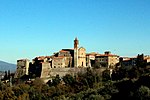The Grand Duchy of Tuscany (Italian: Granducato di Toscana; Latin: Magnus Ducatus Etruriae) was an Italian monarchy that existed, with interruptions, from 1569 to 1860, replacing the Republic of Florence. The grand duchy's capital was Florence. In the 19th century the population of the Grand Duchy was about 1,815,000 inhabitants.Having brought nearly all Tuscany under his control after conquering the Republic of Siena, Cosimo I de' Medici, was elevated by a papal bull of Pope Pius V to Grand Duke of Tuscany on 27 August 1569. The Grand Duchy was ruled by the House of Medici until the extinction of its senior branch in 1737. While not as internationally renowned as the old republic, the grand duchy thrived under the Medici and it bore witness to unprecedented economic and military success under Cosimo I and his sons, until the reign of Ferdinando II, which saw the beginning of the state's long economic decline. It peaked under Cosimo III.Francis Stephen of Lorraine, a cognatic descendant of the Medici, succeeded the family and ascended the throne of his Medicean ancestors. Tuscany was governed by a viceroy, Marc de Beauvau-Craon, for his entire rule. His descendants ruled, and resided in, the grand duchy until its end in 1859, barring one interruption, when Napoleon Bonaparte gave Tuscany to the House of Bourbon-Parma (Kingdom of Etruria, 1801–1807), then annexed it directly to the First French Empire. Following the collapse of the Napoleonic system in 1814, the grand duchy was restored. The United Provinces of Central Italy, a client state of the Kingdom of Sardinia, annexed Tuscany in 1859. Tuscany was formally annexed to Sardinia in 1860, as a part of the unification of Italy, following a landslide referendum, in which 95% of voters approved.












